Change Management plays a pivotal role to speed up transformation, employee engagement and any implementation with respect to people, process and technology. Let us focus on the people factor now.
The overarching objective of an OKR program is really to help the company bridge the strategy-execution gap. Business leaders want to improve visibility and alignment across the various levels of the organization. There are four key challenges in successfully launching an OKR program to transform a business into a solid execution machine
- Executive commitment
- OKR know-how
- Managerial commitment
- Employee engagement
The OKR program team and the different roles people play within that team are designed to overcome these challenges and achieve the overarching goal, which is to bridge the strategy-execution gap and turn your business into a solid execution machine. There are five key roles in every OKR program. They are:
- Executive Sponsor
- Captain – Typically just one, but for larger organizations, more than one.
- OKR Champion – multiple champions, typically one for every department.
- Managers
- Individual Contributors
The following picture clearly illustrates the roles that have been designed to address each specific challenge:
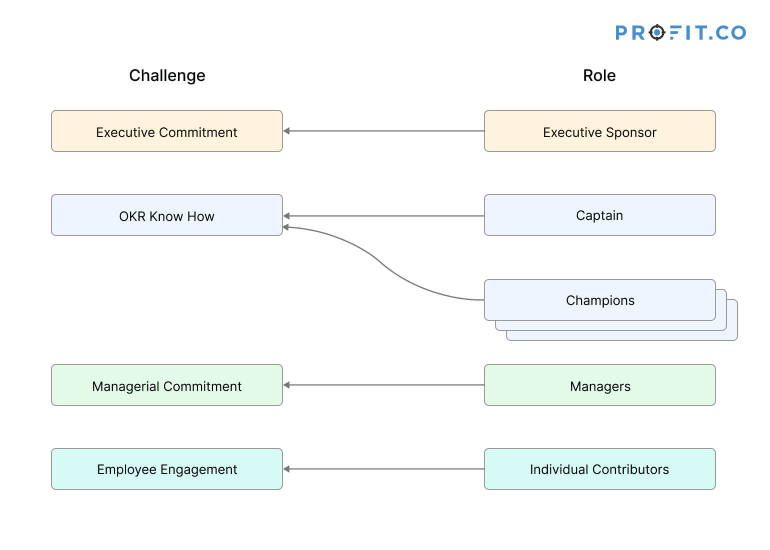
Before delving into the details of every role, the following picture summarizes the key responsibilities for each role.
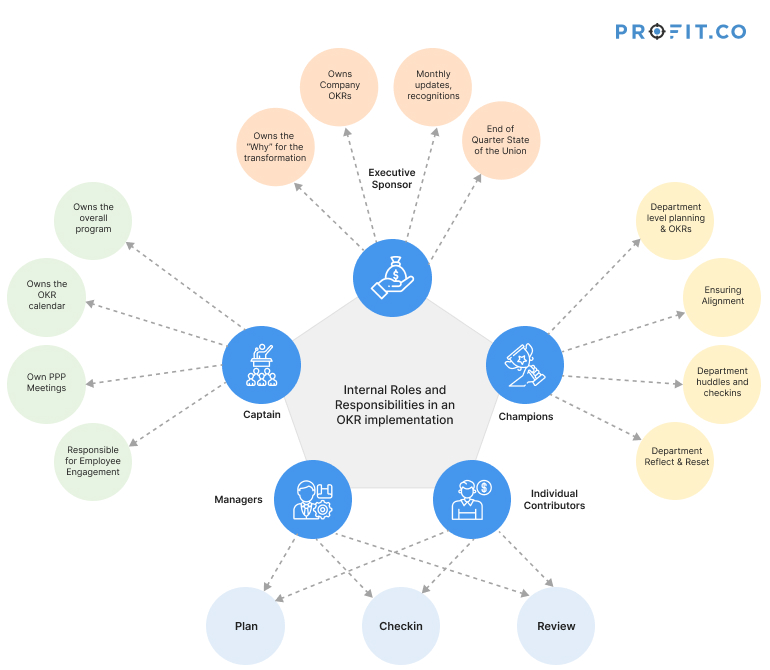
Now let’s look at each role one by one.
Executive Sponsor
If you ask us to just give you a single reason why an OKR program will be successful, it is the executive sponsor. The converse is true as well – if you ask us to give you a single reason why an OKR program could fail, it would be the executive sponsor as well.
The executive sponsor is a very key role, and this is somebody who is really part of the C Suite of the company. The executive that becomes the sponsor typically carries a lot of weight and clout across the company, and they have a name that inspires a significant level of confidence.
Everybody recognizes the importance of this person in the company and knows that their presence means that this initiative matters.
In our interactions with our clients, one of the key concerns for executives before deciding to embark on their OKR journey is their desire to avoid their name being associated with failure. In fact, this is the primary concern. So, the fact that an executive is willing to put their name on the program means a lot for the program. There should be no ambiguity in the minds of every employee that this means business.
Everyone understands that the strategies of the company and the priorities of this executive are in direct alignment and the objectives and key results set by this executive are key to the business’s performance, and that all employees/teams/departments should organize themselves and rally behind this executive.
The executive sponsor needs to create a sense of excitement before you embark on your OKR journey. They need to communicate through multiple channels – email, recorded videos, and town hall meetings. Essentially use all possible channels and communicate to employees why the company is implementing OKRs and what it means to every one of them.
The sponsor and the OKR team should also proactively address any potential fears/concerns that employees may have. You must not leave anything to interpretation. For example, when a new system such as OKRs are implemented, everyone tends to worry about how their performance will be evaluated and how their compensation and career progression will change. It’s important to have a clear position and address them right from the start. For example, think about how you are going to explain the importance of stretch goals.
| Sample kickoff message | ||||||||||||||||||||||||
|---|---|---|---|---|---|---|---|---|---|---|---|---|---|---|---|---|---|---|---|---|---|---|---|---|
|
Hello Everyone, As we head into FY25 focused on a winning strategy for profit growth, execution, and a culture of collaboration, we are introducing a new framework for goal achievement. Being clear about who is accountable for what, when, and how provides a structure for success to help us make faster, better quality, and more aligned decisions that provide exceptional value to our customers and ourselves. OKRs (Objectives & Key Results) is a successful goal management and execution framework used by some of the most respected organizations like Google, Intel, Twitter, LinkedIn, Airbnb, Square, Lyft, and other innovators. OKRs have been used by innovative companies for over 40 years to set and execute organizational, department, and team goals. I encourage you to explore the history and overview of OKRs, some of which you can find here. Why is it important for us? OKRs will enable us to:
What is needed from you going forward? We are preparing the way for you to learn the fundamentals of OKRs. We will be investing significant hours over the next few weeks to train ourselves on OKRs and subsequently outline the corporate objectives so that the next-level OKRs can be clear, meaningful, measurable, and impactful to achieve our goals. Investing the time now to learn and develop our OKR muscles will ensure we are well-positioned for the remainder of the year. Sep and Oct are our learning months. Investing the time now to learn and develop our OKR muscles will ensure we are well-positioned for the remainder of the year. What’s Next? Estimated Timeline: Your participation is requested in the areas below.
Thank you for your time and attention to support the implementation of our FY25 winning strategy for profit growth, executional alignment, and culture of collaboration. I am grateful for your hard work. We are making great progress on many fronts, and with this system in place, I hope that you will experience the positive momentum of our go-forward objectives, better aligned to deliver measurable key results on a quarterly basis, starting with the current quarter. I am counting on you to help make the OKR goal management plan a success. CEO |
Once the program kicks off, the sponsor and the leadership team need to clarify what the organizational priorities are. They need to articulate the vision and strategy of the company and what needs to be executed in the next 3-5 years. From here on, the 2nd level and 3rd level leaders establish their priorities that will be in alignment with the top management. These next-level plans need to have measures and actions established by quarter.
They need to announce the “way of OKRs” and need to clarify clearly what is expected from your employees at every stage. Key points to highlight:
- OKRs are our new way of life at company A and NOT just a flavor of this month.
- OKRs will take the center stage in weekly/monthly/quarterly reviews. It is something that is going to be taken seriously, and done consistently.
- OKRs need to become the muscle memory of the organization. Employees and teams need to develop the necessary new habits that are needed to operate effectively in the new mode – weekly check-ins, regular reviews, reflection and reset exercises, and other similar activities.
This level setting, expectation setting, needs to happen well before starting the OKR program. Right before you start the planning exercise for your first period (quarter, trimester) starts, you have to send out another communication over email with recorded videos, if feasible, where you formally communicate that the planning stage has started and that the first quarter planning will be completed in two to three weeks and some additional pertinent details around the planning process.
Executive sponsors will push employees to take at least one-third of the goal as stretch goals or with stretch targets. They will encourage them to have at least 50% of their OKRs align with the higher level OKRs – either company level or the parent department level OKRs. And they will encourage the teams to be very collaborative, find out dependencies, and state the dependencies ahead of time so that the whole company takes full advantage of the planning process. They will also encourage all employees to attend all the training programs without fail and participate very, very actively. There are frequent communications from the executive sponsor to keep the team moving the chains. So, there is a communication at the beginning of the planning stage, and if required, the executive sponsor sends out reminders in the middle of the planning phase to keep things moving.
But at the end of the planning and before execution starts, once the planning is done, the executive sponsor will send out another email or a recorded video that would communicate:
- That the planning process has been completed and that they are entering the execution phase.
- Call out stretch targets in important areas
Once execution is set in motion, champions work with all the employees to ensure that check-ins happen on time. Check-ins stats are shared regularly within the departments and teams so everyone understands that this is tracked and reported across the company.
OKRs are at the center of all review meetings every week. All the way from executive leadership meetings to small engineering team meetings, OKRs guide the discussion. At this point, you can promote engagement through awards such as:
- Employees who have taken notable stretch targets
- Employees who have done a great job of defining their OKRs
As execution happens, the executive sponsor is also expected to participate in leadership review meetings either on a weekly basis or at least twice a month. Their presence indicates the seriousness, and obviously, they will also be doing their reviews based on OKRs throughout the quarter. They plan an important role in improving employee engagement through words of encouragement, monetary and non-monetary awards at various stages throughout the quarter. They also participate in the learning and celebration meetings and play a key role in implementing the PEEL methodology. In many situations, just the presence of the executive sponsor is going to make a huge difference.
They participate in the end-of-quarter reflect/reset religiously. Essentially they would do it over a series of meetings in the last week where the executive sponsor would be present with their department heads. They would lead a session of reflection where they would encourage people to talk about how the quarter went. A few areas that are included for discussion are:
- All the experiments that they did to achieve the stretch goals
- What worked. What was the business impact?
- What didn’t work. What was the loss to the business? Why?
- Appreciate people who are ready to share their learning.
- Appreciate breakthroughs.
- Encourage failures and talk about how to fail fast and cut losses in those scenarios.
| Sample biweekly message |
|---|
|
Hi Team, Martin Luther King Jr. said, “If you can’t fly then run, if you can’t run then walk, if you can’t walk then crawl, but whatever you do, you have to keep moving forward.” Each of you has refined your OKRs with great precision, and now it is time to move into execution. What Happens Now? We achieve and measure our OKRs. Each Monday, the leadership team will spend an hour reviewing:
Each Friday, the department leaders will spend thirty minutes [give or take] reviewing:
Each Friday, employees with OKRs will spend thirty minutes [give or take]:
On Friday, July 1st, 10 am ET, Profit.co will be hosting the OKR Execution Cadence training which will inform the weekly check-in process and how to document Progress, Plans, and Problems [PPP]. It will be recorded. Starting late next week, you will be introduced to your Customer Success Partner from Profit.co, who will be hosting weekly office hours to help you acclimate to using the software tool and working within the OKR framework. OKR Champions will schedule reminders on your calendars for Fridays in the 2nd Quarter to complete your check-ins and weekly updates. In addition to keeping you on track, these reminders will serve as your cue to provide your leader with the data they need on Monday of each week to review in the leadership team meeting. OKR discipline is critical to improving our execution as a company. Thank you for your engagement in this new process. I am confident we will get stronger with OKRs and become an unstoppable force in the industry. |
In terms of constant communication, there are some templates that can be leveraged.
We started this section off with a question on one reason for OKR program success or failure. We’ll close this section with another similar section. If you ask us what is the one single action of an executive sponsor that will ensure that the program is successful, it is this – conduct your management reviews weekly, monthly, and quarterly with OKRs at the center – that’s it. If you do that, the program thrives. If not, the program fizzles out. Very simple.
Ready to start your OKR change management program today?
Champions
Champions are departmental representatives into the OKR steering committee. Champions are potential OKR Center of Excellence (CoE) members. Some organizations establish a center of excellence for OKRs that can act as an internal expert team that helps other employees become better at OKRs. So we are really looking at people who are promising talents. They don’t have to be the department leaders. They could be from the second level or third level.
An ideal champion is someone with a very positive attitude and who is generally accepted well by their colleagues. They’re respected and accepted by the rest of their team not because of their designation but more because of their sincerity, integrity, and how they actually work with others. They are generally seen as people who give more than take from the system. So they have that acceptance among the rest of the group. So you look for people who are:
- Good performers
- Have the drive to change things for the better
- Willing to volunteer and take a little extra load
- Don’t have to be super senior
In summary, these are your promising leaders. So a lot of times, these champions actually become a way for you to build a high-performance team and identify your future leaders. So you first start looking for people with that sort of a background.
Once you identify your champions, you have to ensure that they learn very well during the OKR coaching program. They should get themselves certified and pick up the best practices of writing OKRs very, very well. They should develop the expertise enough so that they can teach this later to their colleagues.
When we create our annual and quarterly business plans at various levels of the company, we tend to assume that employees have an understanding of what the company goals are, how their contribution affects the company’s goals and what are the interdependencies with other departments. That is not always the case. That is the first job of champions. They should understand the big picture, and at the same time, they should be able to drill down to the details of their own department.
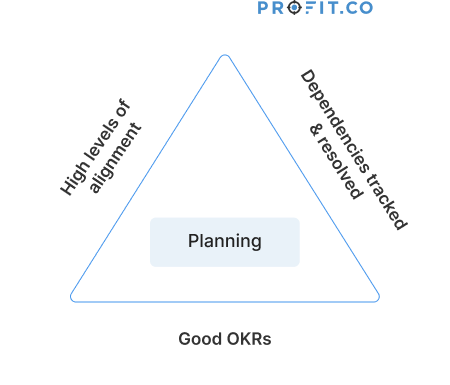
Thus, during the planning stage, they play a very active role in evaluating all possible or suitable candidates to drive OKRs in the departments. Then as the planning process happens, these people make sure that the OKRs that they define conform to the best practices. They should also ensure that their OKRs should have high levels of alignment with their parent organizations (either departments or divisions or the company). At least 50% of their OKRs should contribute to the higher-level OKRs. They also very carefully analyze dependencies with other departments and ensure that they are accounted for.
During the planning stage, they make sure that planning has happened in all the departments by going and checking at every level within their organizational area of responsibilities. They are the primary representatives and take responsibility for making sure that within their department, trains are running on time and the schedules are kept. To ensure that their actual schedules track plans:
- They have to nudge some people who need that extra push
- Facilitate extra help for those that need some additional help
- Train people on the areas they lack
- Escalate to appropriate leaders where needed
- Resolve dependencies with other departments where needed
Champions are also a knowledge hub in terms of both the OKR concepts and the tools that make up the solution. So they absolutely are on the cutting edge with respect to the concepts and always willing to change based on new learnings. They actively seek/learn tools to monitor the health of the program as measured by:
- Check-in discipline
- Plan vs. Actual progress
- Employee engagement
To improve employee engagement, champions play an important role in identifying and nominating people from their departments for the various awards for the month/quarter. Champions play a very important role in ensuring that the environment/culture is aggressive and fun.
They also coordinate the monthly learning/celebration meetings. These include:
- Identifying key learnings and celebration items
- Preparation of material to be shared during the meeting highlighting key learnings and achievements
- Identifying some key presenters and coach them to share their story on how they went about their stretch goals and their learnings.
- Facilitate implementation of key learnings through OKRs in the subsequent quarters.
Champions are very entrepreneurial. They have a great attitude and grit. They watch their part of the OKR program like a hawk and get things done. And what we have found is that over a period of two to four quarters, champions become such experts that they naturally become OKR Center of Excellence (CoE) members. And in many cases, we have found that companies find them to be amazing future leaders, and they’re even put on the fast track for leadership.
From a leadership development perspective, the responsibilities and characteristics outlined above are pretty much what they already do, or they’re supposed to be doing.
- They should be doing department-level planning for a quarter or for six months or whatever their planning horizon is. They should be doing some planning.
- They should be validating the plan, and they should be ensuring that the status is updated regularly.
- Then, at the end of the period, conduct reviews to assess what you planned versus what you did, and then also plan for the next quarter.
So what we have listed here as the champion’s responsibilities are all handled today by the manager or some combination of managers in the department. Now that this champion is able to contribute to these areas, the managerial bandwidth gets increased. Managerial availability gets increased, which was one of the original constraints we talked about.
It’s very common for you to experience calm in your execution if you have a solid OKR champion for your department:
- You’ll simply set targets and manage through check-ins and periodic reviews.
- There won’t be any meaningless arguments.
- No repeated follow-ups or annoying email reminders.
Basically with that extra bandwidth, managers can focus on the business and on shaping the long-term strategic directions of the business. Using OKRs to define and track numbers and work that you’re already tracking through other means provides a common interface even between departments which makes life easier for everyone.
Captain
The Captain is actually the overall program owner, and they are the single most important human resource that influences the success of the OKR program. They’re identified along with the OKR program, and the buck stops with them when it comes to the OKR program. Their involvement starts right from this stage, where the OKR program itself is conceived.
Early involvement
Often, discussions start at the executive level when you have started noticing the strategy execution problem – which may be one or a combination of the problems we have documented before – focus, alignment, commitment, tracking, and sometimes stretching. OKRs is one solution to this problem. Typically you have a few options and OKRs is one of the solutions. The Captain is involved from early on, sometimes the first voice for OKRs. They have some background – either they have read about OKRs or may have been the Captain or champion at one of their previous jobs.
Many times we have seen extremely high levels of interest where senior executives want to be the Captain themselves. But it’s not practical since they don’t have the time and bandwidth. So they would like to find somebody who can do the job as well as they can do. So that’s the level of importance of the role.
The Captain gets involved very early. They are involved in the selection of the consultants and the software vendor. So to that extent, even that decision, they have actually staked their career choices right from the selection of the vendor. Once we have selected the Captain, typically, a part-time executive assistant is assigned to them in many large organizations since it is a very demanding role.
Program responsibilities
The Captain is responsible for putting the entire program plan. Depending on the organization’s culture, the organization may decide to go full blast. They may try to bring, let’s say, a thousand people in their first quarter, or they may have a more measured approach to rolling out. So they first decide, based on their knowledge of the organization’s culture, what sort of implementation would suit their organization. What should be done in the first quarter? What should be done in the second quarter? And so on. A very detailed program plan is prepared.
The Captain is empowered to navigate through the organization as they please and is also well aware of the inner internal policies and processes of their organization. There are many curve balls that get thrown throughout an implementation. For example, new system integration needs to keep coming to ensure that change management is smooth.
Wherever they see some problems with the program plan, they play a very proactive role to ensure that they are able to match their promises with delivery. There are schedule risks, budget risks, and other risks that need to be managed.
Demonstrated success in previous roles
The Captain is someone who has demonstrated success in their previous roles within the company or outside. This is important from 2 perspectives, both relating to confidence:
- Boost self-confidence, so decisions are well thought through and not tentative
- Boost the confidence of other people, so they trust the Captain and look up to them rather than second-guessing them
Since the entire organization’s strategy execution is at stake here, you choose that sort of a person who has demonstrated success consistently in the past. The person has such respect in the organization that the entire organization automatically places the same level of respect for the OKR program.
Decision Makers
Captains make decisions and have some authority and responsibilities. They are not postmen. While they try to achieve the priorities of the executive leadership team through OKRs and alignment, they are simply not the mouth pieces of the executive team. And they shouldn’t be running to the executive team for every little decision.
They have a solid reputation. Employees know the importance of the program just by the fact that this person is the Captain. Everyone realizes that the organization is actually giving a lot of importance to this program.
Orchestrates Reviews
They orchestrate the weekly or biweekly reviews at the company level. Department-level meetings are handled by the champions, but the Captain handles the company-level reviews. In terms of the agenda for the company review, it is fairly flexible and depends on which function or process is the most important or bottlenecked.
For example, one of our customers who manufactures footwear had huge challenges with shipping. So, logistics was given a permanent place in every operating review.
The agenda is very similar to what you have in operating reviews. These are some other standard agenda items for reviews:
- Look at ambers and reds first. Ensure that progress can be picked back up. If not, figure out chain reactions and understand the bigger impact on the rest of the organization and, finally on company objectives.
- Celebrate achievements
- Encourage breakthrough thoughts and contributions.
Process Vs. Culture Experts: Who can be a better Captain?
Most Captains come from 2 backgrounds – HR & PMO (Program Management Office). PMO means the traditional program management office, but also can mean the modern Chief of Staff and other roles that are focused on operations.
Now, we know that there are 2 key pillars for every OKR Enablement exercise – Process & Culture. The bigger question really is how do you prepare yourself to be a great Captain?
- If you’re from HR, what should you watch for?
- And if you’re from PMO, what should you watch for?
When you come from an HR background, you generally have an edge over others on the culture side. But you have to really learn the methodology, with the process of OKRs, and many times it gets confusing to distinguish between individual performance and business performance since HR experts are deeply involved in employee performance and employee engagement. So, partnering with a strong program manager will help.
In our experience, many times this blind side is not well understood and results in a false start. And the most common conclusion is that “OKRs didn’t work for us.” You really need to know that – Culture & Process – are different. And invest your time to learn the methodology, do some extra bit of heavy lifting to learn the area where you are weak at. You also need to know that others know this weakness. So, either get yourself equipped or partner with someone who has the skill. You have to realize that for you to be perceived as a strong Captain, you don’t necessarily have to be an expert in every function and that you would have to come up with objectives and key results for every department. That’s not really the requirement. That’s something the champions have to facilitate.
You have to be able to make program-level decisions. For example, you need to be able to say that check-ins have to be done every two weeks, which means understanding the culture and making sure that two-week check-ins will work in this company. Or weekly, or once a month. These decisions need to be made and having a good grasp of the process and culture aspects of your company is key for that.
When you come from the PMO background, you generally have an edge over the others on the process side. You are already pretty baked in with the whole processes, status reports, and timelines. But you have a cultural weakness. You have to start appreciating that culture plays a big role in the success of an OKR program. And prepare yourselves or identify a partner in HR who can jointly run the program with you.
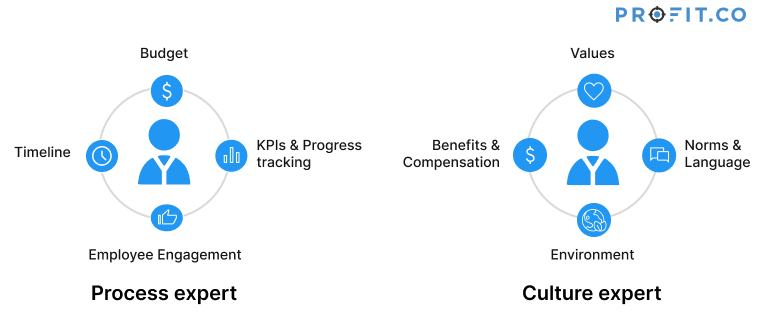
These weaknesses will show up in different ways and angles and will lead to a lot of frustrations down the line. For example, when validating the program plan, a Captain with a PMO background will be able to look at it and immediately identify 4-5 different risks, but a Captain with an HR background may not be able to do that. So, get this issue addressed right at the beginning of rolling out the OKR program. Assembling a solid team is part of the early program decisions and obviously has a long-lasting impact and, many times very foundational.
Managers
Managers at various levels in an organization are the ones that are tasked with getting work done. So planning, check-ins and reviews are how managers go about their work. Managers at various levels need to stay on top of the initiatives that drive their numbers. Managers work with the champion of their department and the Captain to plan their initiatives, distribute work amongst their teams, track and achieve the desired results.
Managers participate in the transformation to OKRs with a small amount of time investment. The transformation program is designed to facilitate that.
Individual Contributors
Majority of the employee pool in every organization belongs to this category and hence the participation of this group is super critical to the success of any OKR program. In our experience, we have found that the culture of this group defines the culture of an organization. That is the reason why employee engagement is a key success factor. OKR programs work very well in an organization where the majority of the people are positive about their company and their professional outlook than in companies where the people aren’t that positive about the outlook.
We have found that the majority of the people really want to contribute well to the company, and they want to do justice to the job. They are people who have good work ethic. So, in general, everyone wants to do the best for their organization and for their company, but the overall outlook is a key factor in encouraging employees to pull the extra weight that is needed to transform an organization. So, the executive and OKR program team should enable their employees to enthusiastically adopt the OKR methodology to transform their business. They need to provide their employees with the tools and coaching to excel using the methodology.
When a particular employee or group of employees needs some additional coaching, the Captain and the appropriate champion should teach them how to overcome those challenges. If someone is lacking the check-in discipline, the appropriate champion needs to do one-on-one sessions with those employees and help them out.
Once we get to a stage where employees perform their duties according to the appropriate cadence set, the routines become habitual. They say you have to repeat something for 60+ times before it becomes a habit. And then you achieve a new equilibrium where everyone feels comfortable and confident. This is when your business achieves a stage where you can feel the ratchet effect You cannot go back to the previous stage anymore.
You will reach a stage where you will even plan for absences and PTOs. We had a very interesting question from a client. They wanted a feature to allow check-ins to not be indicated as missing or late when people are on PTO. The key question is – does the business stop running when people are on PTO? When you talk about the execution of the business, or the execution of a department, you have to look beyond an individual. If an individual is gone for a few days, it doesn’t mean the business is going to stop. So what do you do? You proactively plan and add more than one person as responsible for the check-in or make someone else responsible for check-ins when the primary individual is on PTO.
Check-ins are the holy grail, and along with the associated weekly/monthly reviews, can help you keep an eye on the pulse of your business. We are going to have awards for people who have the best check-in record and for those who have done the most effective review meetings.
So you need to work towards creating a system where all these different activities come together and connect well to provide a platform for employees and teams to set goals/targets and work towards achieving them.
Time Commitment from the various resources involved in the OKR program

Now that we’ve seen the different resources that participate in a company’s journey, let’s look at the time commitment for each resource/role. There are no perfect answers, but an indicative commitment level is summarized below:
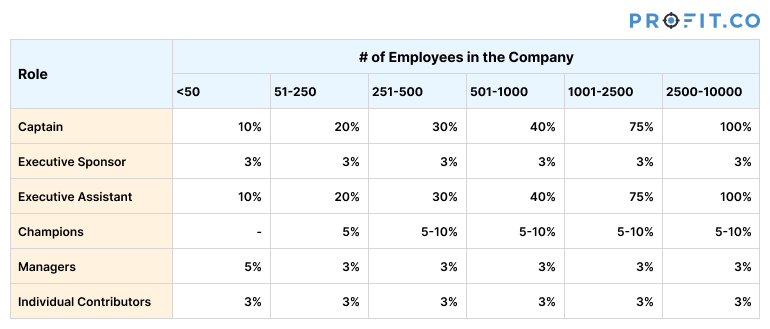
- You’ll need approximately 1 Captain for every 2500 employees. They are the anchors for the OKR program. So, their commitment levels will be relatively high.
- As we already discussed, the Executive sponsor will lead high-level OKR reviews, run reflect town halls, and will communicate regularly with the entire company on accomplishments and program course corrections. Relatively low time commitment.
- The role of the executive assistant is primarily to support the Captain and will be directly correlated with the amount of time required from the Captain.
- You will need a champion for every team. Their level of effort will vary depending on the team size and complexity. But in larger organizations, they tend to take up some load from the Captain and some from the department/team managers.
- Managers & individual contributors will have a relatively lower time commitment
Bridge the gap and start your OKR change management journey
Related Articles
-
What is “Distance” in the REDUCE Framework From the Book Catalyst?
Bastin Gerald Founder & CEO at Profit.co Last updated: May 21, 2024 In "The Catalyst," Jonah Berger introduces the REDUCE... Read more
-
“Burn the Ships” Strategy for Effective Change Management in Business
Bastin Gerald Founder & CEO at Profit.co Last updated: May 17, 2024 In the realm of change management, the "burn... Read more
-
Costs of Inaction in Business
Bastin Gerald Founder & CEO at Profit.co Last updated: May 17, 2024 Documenting the cost of inaction in a business... Read more
-
What are the Drivers for Change?
Bastin Gerald Founder & CEO at Profit.co Last updated: June 23, 2025 As an organization, there are times when you... Read more

